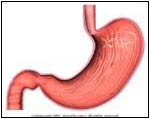|
|
 |

Normal |

Abnormal |
| |
- The esophagus is the tube in the chest that carries food from
the mouth to the stomach. If the esophagus becomes irritated,
infected, or inflamed, it creates a condition known as esophagitis.
|
 |
- Pain in chest on swallowing
-
Thrush (white patches) in mouth may be present
in candida esophagitis
- Caustic ingestion
- Burning chest pain
- Gagging
- Difficulty swallowing
- Drooling
- Wheezing
- Whistling sound in neck
(stridor)
|
 |
- Reflux esophagitis resulting form gastroesophageal reflux disease, also
called
GERD or acid reflux.This the most common cause when the stomach
contents are regurgitated into the esophagus. The contents include gastric
acid, enzymes such as pepsin, and bile which irritate the surface cells
of the esophagus known as squamous epithelium, and eventually lead
to erosion , ulceration of esophageal and may eventually even become
premalignant a condition termed Barrett esophagus.See
GERD
- Erosive Esophagitis involves damage to the esophageal tissue similar
to the reflux esophagitis.This damage is often called an erosion.
This can occure secondary to reflux or ingestion of caustic agents and
chemicals see other causes
- Infections:
Fungi:
- Candida (yeast) -- usually in individuals with other diseases such
as diabetes, cancer, or HIV.
- Less often even other fungi such as Aspergillus, Histoplasma, Cryptococcus, Blastomyces
Viruses:
- Viruses such as Herpes and Cytomagalovirus, Varicella-zoster virus ,
Epstein-Barr virus , Human Papillomavirus , and even Poliovirus
Bacteria:
- Bacterial infections such as the normal stomach flora,
Mycobacterium tuberculosis, Mycobacterium avium-intracellulare,
others especially in those with HIV infection or AIDS
Parasitic infections:
Chagas disease, Trypanosoma cruzi, Cryptosporidium, Pneumocystis,
Leishmania donovani
- Medication -- examples include Potassium, and antibiotics such
as tetracycline
- Nonsteroidal anti-inflammatory drugs (NSAIDs)
- Quinidine and some chemotherapy agents such as dactinomycin, bleomycin
cytarabine, daunorubicin, 5-florouraacil, methotrexate, vincristine.
- Caustic injury (e.g., accidental ingestion of drain cleaners)
- Systemic disorders and other conditions associated with esophagitis:
- Behcet disease
- Chronic granulomatous disease
- Collagen vascular diseases
- Inflammatory bowel disease
- Sarcoidosis
- Metastatic cancer
- Pemphigus vulgaris
- Cicatricial pemphigoid
- Epidermolysis bullosa
- Bullous pemphigoid
- Drug-induced skin disorders i.e, Stevens-Johnson syndrome,
toxic epidermal necrolysis, erythema multiforme.
- lichen planus, psoriasis, acanthosis nigricans, leukoplakia.
- Graft versus host disease (GVHD).
|
 |
- Endoscopy with biopsy and brushings (done by passing scope via the
mouth into the esophagus)
|
 |
-
GERD
(gastroesophageal reflux disease) and Erosive Esophagitis and other
illnesses and conditions related causing esophagitis see those sections
- Candida esophagitis (choice of
medications depends on severity):
- Nystatin swish and swallow
- Fluconazole by mouth
- Ketoconazole by mouth
- Amphotericin B intravenously
- Fluconazole intravenously
- Cytomegalovirus esophagitis
- Ganciclovir intravenously
- Foscarnet intravenously if
ganciclovir fails or is not tolerated
- Herpetic esophagitis:
- Normal individuals -- often do not need treatment
- Immunocompromised (e.g., have underlying disease like HIV)
-Acyclovir oral or intravenously
-Foscarnet if acyclovir fails
- Stop the offending medication
- Seek immediate emergency medical treatment. The cause is usually accidental ingestion in children or suicide attempts in adults. It is essential that the airway be protected. Chest and abdominal X-Rays are used to rule out perforation, while endoscopy is performed to assess the degree of injury.
|
 |
|
| | |
If you want your friend to read or know about this article, Click here
 |
|
|

